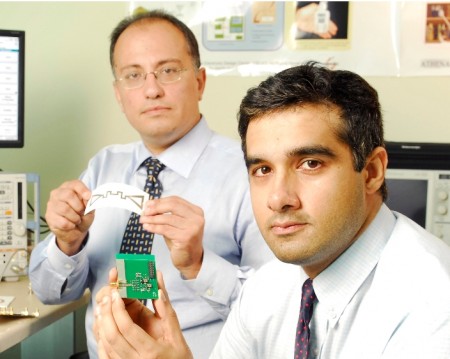Jul
8
A Printed Antenna That Harvests Power
July 8, 2011 | 1 Comment
At the Georgia Tech School of Electrical and Computer Engineering professor Manos Tentzeris, a faculty researcher in the Georgia Electronic Design Center, is leading a team that’s discovered a way to capture and harness energy transmitted by such sources as radio and television transmitters, cell phone networks and satellite communications systems.
Tentzeris explains, “There is a large amount of electromagnetic energy all around us, but nobody has been able to tap into it. We are using an ultra-wideband antenna that lets us exploit a variety of signals in different frequency ranges, giving us greatly increased power-gathering capability.”

Ultra Wideband Electromagnetic Antennas. Professor Tentzeris holds a sensor (left) and an ultra-broadband spiral antenna for wearable energy-scavenging applications. Both were printed on paper using inkjet technology. Click image for the largest view. Image credit: Gary Meek
Not only is the team harvesting enough electromagnetic radiation to make it worthwhile, the team is using inkjet printers to print combined sensors, antennas and the energy-scavenging capabilities on paper or flexible polymers. It’s the energy harvested, the tool printed, self-powered and ready for use – all on a sheet of paper. That brings a gasp for the implications. Times are changing.
The sensor field is ideal – self-powered wireless sensors could be used for chemical, biological, heat and stress sensing for defense and industry; radio-frequency identification (RFID) tagging for manufacturing and shipping, and monitoring tasks in many fields including communications and power usage.
There are lots of sources transmitting electromagnetic energy in the universe. Proximity to a transmitter is going to help, but there is no place in the open where there is no power at all. Electromagnetic energy is transmitted in many different frequency ranges, or bands. The team’s scavenging devices can capture this energy, convert it from AC to DC, and then store it in capacitors and batteries. The scavenging technology can take advantage presently of frequencies from FM radio to radar, a range spanning 100 megahertz (MHz) to 15 gigahertz (GHz) or higher.

Ultra Wideband Electromagnetic Antennas and Energy Scavenging Device. Rushi Vyas (front) holds a prototype energy-scavenging device, Professor Tentzeris displays a miniaturized flexible antenna that was inkjet-printed on paper and could be used for broadband energy scavenging. Click image for the largest view. Image credit: Gary Meek.
The team’s experiments of gathering in the TV bands have already yielded power amounting to hundreds of microwatts, and multi-band systems are expected to generate one milliwatt or more. At a milliwatt, the power is enough to operate many small electronic devices, including a variety of sensors and microprocessors.
Note that storage isn’t explained so far. That’s because combining energy-scavenging technology with super-capacitors and cycling the operation to match power built up, the Georgia Tech team expects to power devices requiring above 50 milliwatts. This method builds up energy in a battery-like supercapacitor and when the required power level is reached a burst is used to work for a brief work period.
So far the team has successfully operated a temperature sensor using electromagnetic energy captured from a television station that was half a kilometer distant. That’s a start, so now they’re preparing another demonstration in which a microprocessor-based microcontroller would be activated simply by holding it in the air.
What makes the team’s work exemplary is exploiting a range of electromagnetic bands. Harvesting across the widest possible spectrum increases the dependability of energy-scavenging devices. The antenna-harvesting device could be used by itself or in tandem with other generating technologies. For example, scavenged energy could assist a solar element to charge a battery during the day. At night, when solar cells don’t provide power, scavenged energy would continue to increase the battery charge or would prevent discharging.
But the marvel is in utilizing inkjet technology to print the full energy scavenging devices on paper or flexible paper-like polymers. The technique is already used to produce sensors and antennas separately. Combined the technology offers paper-based wireless sensors that are self-powered, low-cost and able to function independently almost anywhere, now.
They should be quite low cost. To print electrical components and circuits, the Georgia Tech team uses a standard materials inkjet printer. But they add what Tentzeris calls “a unique in-house recipe” containing silver nanoparticles and/or other nanoparticles in an emulsion. This approach enables the team to print not only RF components and circuits, but also novel sensing devices based on such nanomaterials as carbon nanotubes.
It’s been a long road. Rushi Vyas, a graduate student who is working with Tentzeris and graduate student Vasileios Lakafosis, remembers Tentzeris began his research group for inkjet printing of antennas in 2006 when the paper-based circuits only functioned at frequencies of 100 or 200 MHz.
They’ve come a long way, “We can now print circuits that are capable of functioning at up to 15 GHz — 60 GHz if we print on a polymer,” Vyas said. “So we have seen a frequency operation improvement of two orders of magnitude.”
As power needs decrease and tool designs reach further into optimizing efficiency more sensors and other devices that self-power are going to be a boon. Not just from the expected low cost, but the nearly no cost to install and use. This is great work that will make a big difference.
Comments
1 Comment so far


that is good work .developing human interligent.
dear sir I like make this anterna and look genarate power .i am from srilanka .rural area has not electricity .so our village people can use this method .can u help us? i am an electonic technician.thank u